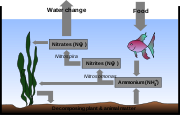
Ammonia Poisoning
Encyclopedia
Ammonia poisoning is a common fish disease in new aquarium
s, especially when immediately stocked to full capacity. Ideally, the level of ammonia (NH3) and ammonium compounds (i.e. those containing NH4+) should be zero. Although trace amounts are generally harmless, they can still lead to problems over time. Understanding the nitrogen cycle
is essential for the keeping of any aquatic life. The amount of ammonia present is usually accompanied by a rise in pH
. As ammonia is a base, it is stabilized by alkaline water. It can cause damage to the gills at a level as small as 0.25 mg/L.
Symptoms include:
 Ammonia poisoning is impossible to cure, however it can be prevented easily by first cycling the tank (see below). Treatments include immediately reducing the ammonia level through many small water changes. Alternatively an ammonia detoxifier can be used, though such chemicals are best used in emergencies only, and do not provide a substitute for adequate tank cycling. Once the ammonia is removed, the fish may recover if the damage is not too extensive. Increasing aeration
Ammonia poisoning is impossible to cure, however it can be prevented easily by first cycling the tank (see below). Treatments include immediately reducing the ammonia level through many small water changes. Alternatively an ammonia detoxifier can be used, though such chemicals are best used in emergencies only, and do not provide a substitute for adequate tank cycling. Once the ammonia is removed, the fish may recover if the damage is not too extensive. Increasing aeration
may be desirable, as the fishes' gills are often damaged by the ammonia. This can increase the probability of survival slightly. Also, all other sources of stress should be removed, and the cause of the ammonia should be addressed.
Aquarium
An aquarium is a vivarium consisting of at least one transparent side in which water-dwelling plants or animals are kept. Fishkeepers use aquaria to keep fish, invertebrates, amphibians, marine mammals, turtles, and aquatic plants...
s, especially when immediately stocked to full capacity. Ideally, the level of ammonia (NH3) and ammonium compounds (i.e. those containing NH4+) should be zero. Although trace amounts are generally harmless, they can still lead to problems over time. Understanding the nitrogen cycle
Nitrogen cycle
The nitrogen cycle is the process by which nitrogen is converted between its various chemical forms. This transformation can be carried out by both biological and non-biological processes. Important processes in the nitrogen cycle include fixation, mineralization, nitrification, and denitrification...
is essential for the keeping of any aquatic life. The amount of ammonia present is usually accompanied by a rise in pH
PH
In chemistry, pH is a measure of the acidity or basicity of an aqueous solution. Pure water is said to be neutral, with a pH close to 7.0 at . Solutions with a pH less than 7 are said to be acidic and solutions with a pH greater than 7 are basic or alkaline...
. As ammonia is a base, it is stabilized by alkaline water. It can cause damage to the gills at a level as small as 0.25 mg/L.
Diagnosis
A history of the tank: filter changes, power outages, excessive feeding, or the addition of microbicidal or antibiotic agents to aquarium can aid in diagnosis. An ammonia test is the most sure way of diagnosing ammonia poisoning.Symptoms include:
- Purple, red or bleeding gillGillA gill is a respiratory organ found in many aquatic organisms that extracts dissolved oxygen from water, afterward excreting carbon dioxide. The gills of some species such as hermit crabs have adapted to allow respiration on land provided they are kept moist...
s - Fish may clamp, may appear darker in color
- Red streaking on the fins or body
- Fish may gasp for air at the surface of the tank water
- Torn & jagged fins
- Fish may appear weak and lay at the bottom of the tank
Prevention

Aeration
Aeration is the process by which air is circulated through, mixed with or dissolved in a liquid or substance.-Aeration of liquids:-Methods:Aeration of liquids is achieved by:...
may be desirable, as the fishes' gills are often damaged by the ammonia. This can increase the probability of survival slightly. Also, all other sources of stress should be removed, and the cause of the ammonia should be addressed.

